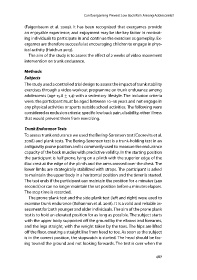Page 487 - Pedagoška vizija / A Pedagogical Vision
P. 487
Can Exergaming Prevent Low Back Pain Among Adolescents?
(Faigenbaum et al. 2009). It has been recognized that exergames provide
an enjoyableexperience, andenjoyment maybethe keyfactorinmotivat-
ing individuals to participate in and continue the exercises as gameplay. Ex-
ergames are therefore successful at encouraging children to engage in phys-
ical activity (Haichun 2013).
The aim of the study is to assess the effect of 2 weeks of video movement
intervention on trunk endurance.
Methods
Subjects
The study used a controlled trial design to assess the impact of trunk stability
exercises through a video workout programme on trunk endurance among
adolescents (age 15.8 ± 1,4) with a sedentary lifestyle. The inclusion criteria
were: the participant must be aged between 10–18 years and not engage in
any physical activities or sports outside school activities. The following were
consideredasexclusioncriteria:specificlowbackpain,disability,otherillness
that would prevent them from exercising.
Trunk Endurance Tests
To assess trunk endurance we used the Bering-Sørensen test (Coorevits et al.
2008) and plank tests. The Bering-Sørensen test is a trunk-holding test in an
antigravity prone position and is commonly used to measure the endurance
capacity of the back muscles with predictive validity. In the starting position
the participant is half prone, lying on a plinth with the superior edge of the
iliac crest at the edge of the plinth and the arms crossed over the chest. The
lower limbs are strategically stabilized with straps. The participant is asked
to maintain the upper body in a horizontal position and the timer is started.
The test ends if the participant can maintain the position for 4 minutes (240
seconds) or can no longer maintain the set position before 4 minutes elapses.
The stop time is recorded.
The prone plank test and the side plank test (left and right) were used to
examine trunk endurance (Bohannon et al. 2018). It is a valid and reliable as-
sessment for both younger and older individuals. The aim of the prone plank
test is to hold an elevated position for as long as possible. The subject starts
with the upper body supported off the ground by the elbows and forearms,
and the legs straight, with the weight taken by the toes. The hips are lifted
off the floor, creating a straight line from head to toe. As soon as the subject
is in the correct position, the stopwatch is started. The head should be fac-
ing toward the ground and not looking forwards. The test is over when the
487

